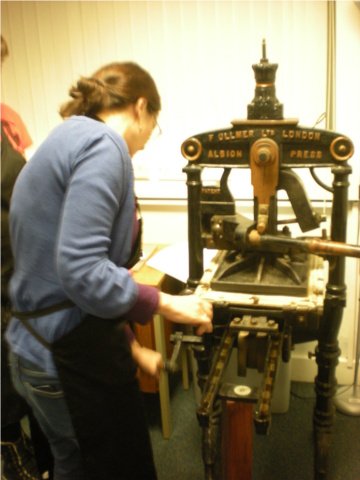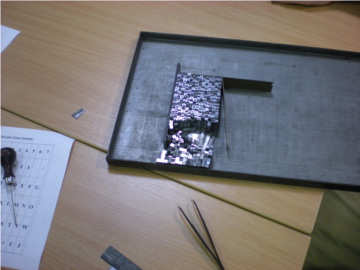Hands-On Printing Workshops at the CTS at 4-6pm on 2 November and 9 November 2016
Booking
To book a place for these workshops, email the CTS's Paul Brown.
Printing the Old Way
For most of the history of the printed book the words were put together in a printing press by the process of hand-setting. Men called compositors--they were always men--would look at the author's manuscript (the copy) and work letter-by-letter, word-by-word, and line-by-line picking out of a typecase individual pieces of type, each containing one letter or piece of punctuation, and placing them in a small tray called a composing stick. The line of type in the stick reads from left to right (as does the copy) but each one is placed upside down so that a new line may sit upon its predecessor as the page is built up.
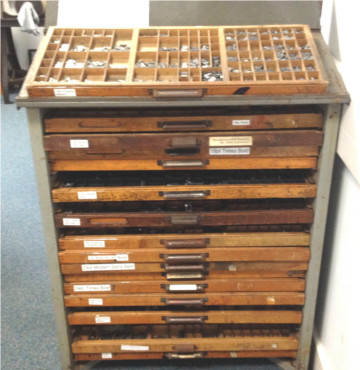
(A cabinet full of typecases, with one on top)
After the compositor had set perhaps six lines of type, his composing stick was full and he moved the type, carefully held as one block by the fingers, from the stick into a tray called a galley. The compositor repeated this process until the galley held all the type for one page of the book, and then he tied the page of type with cord to keep it together until it was ready to be imposed.
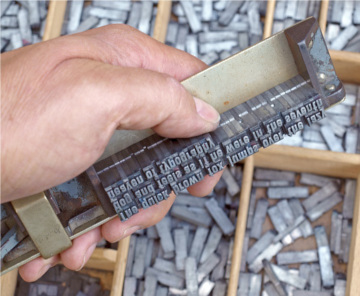
(Compositor holding 2½ lines in his stick)
This last process, imposition, is the bringing together of two or more pages of type to make what is known as a forme, which consists of the type pages--topped and tailed by such things as running titles, page numbers and catchwords--held in a frame called a chase. The rectangle of loose pieces of type had to be pressed together within the chase in order for it to behave as one solid block of type and be ready to be moved to the printing press. Once in the press, it was inked, paper was placed on top, and a heavy block called a platen was forced down onto the paper, pushing it onto the ink type and so an impression was taken. Across the centuries since Johannes Gutenberg invented this process around 1450 the details changed somewhat--early presses were made of wood, later ones were made of metal, and the Victorians added steam engines for automated running--but the essential details remained the same.
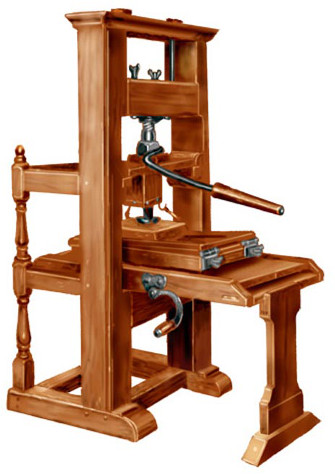
(Wooden printing press c. 1750)
If we want to understand the literary and historical culture of the past 500 years we need to understand how people made the books in which that culture was, for the most part, embodied. The processes of printing were subject to many kinds of mistakes so that the printed books do not quite represent what was in the authors' manuscripts, and moreover the limitations as well as the advantages of printing shaped what authors wrote and how readers apprehended their writing.
Our 2014 session went like this ...
Hands-On Learning
To enable graduate students to get a feel for how books were made in the hand-press era, the Centre for Textual Studies (CTS) at De Montfort University recently organized a pair of hands-on printing sessions. The sessions were attended by graduate students and their tutors from the University of Birmingham, the Shakespeare Institute and Leicester University and was led by Gabriel Egan and Paul Brown of the CTS
Using as our copy the first poem in Shakespeare's collection called Sonnets, printed by hand in 1609, the students broke into teams to set the type using the equipment of the CTS's printing laboratory. In the first of two 2-hour sessions the students acted as compositors, working letter-by-letter through the poem and selecting the right pieces of type from their typecases. As with learning to use a keyboard, the location of each letter in the typecase is something that has to pass into muscle memory with practice and at the beginning the process is slow and frustrating. Even within the short time available, however, students noticed that for the most commonly used letters--t, e, and a in English (how British)--the hand soon knows where to go, and that it is the least frequently used letters that have to be hunted for. With each team setting a couple of lines, the first session ended with seven pairs of lines safely stored in seven galleys, the metal trays used to hold type during typesetting.
(Our Albion iron press in use.)

(Building the poem line-by-line within a galley)
The second session started with students working to bring those seven pairs of lines together in the right order and place them upon the imposing stone, a flat surface where one or more pages of type are put together to make a forme: all the type needed to print one side of a sheet of paper.
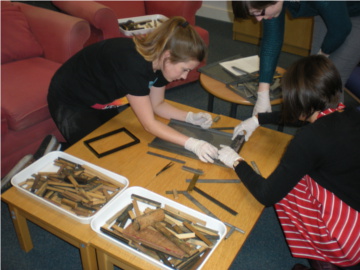
(Students combining their individual pairs of lines in a galley)
Although we did not have time to try it, it is possible to print 4, 8, 12 or even 16 pages on each side of a sheet of paper and then to fold it in such a way that it forms a multi-page gathering, like a pamphlet, in which all the pages are in the correct reading order. It is easy when moving the type from the galley to the imposing stone to pie the type: knocking it off its ends so that a neat rectangle of type becomes an unusable heap.
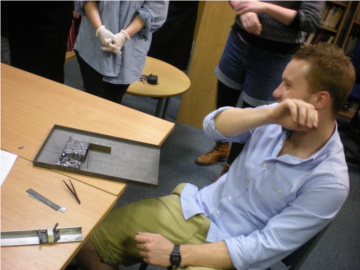
(CTS's Paul Brown demonstrating how easy it is to pie the type)
Once the 14 lines of Shakespeare's first sonnet were on the imposing stone, the students placed over it the rectangular frame called a chase and filled the gaps between the type and the chase with wooden furniture and wedges called quoins. When the quoins are tightened they should lock the entire forme into a single body of type that can be safely lifted and carried to the press. This took some time as getting an even pressure all around the type is fiddly.
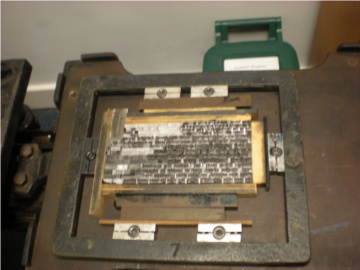
(A forme of type holding Shakespeare's first sonnet)
With the forme finally imposed, and another forme containing a brief title-page being constructed, the students put their forme onto the bed of the CTS's 19th-century Albion iron printing press. After rolling a small amount of ink into a smooth rectangle on the inking table, the students inked the type, laid a sheet of modern paper over it, lowered the tympan, turned the rounce to roll the carriage (holding the type) under the platen, and then pulled the bar of the press to lower the platen on to the tympan and thus apply pressure to the paper to push it onto the inked type. Releasing the bar, turning the rounce again to bring the carriage back, lifting the tympan, and carefully pulling the paper off revealed the results . . . a competently executed first impression.
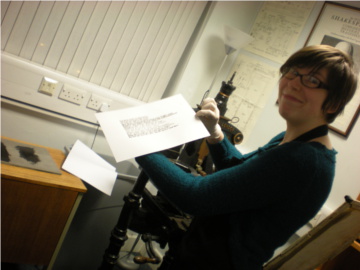
(A reasonable first impression)
One of the students took on the role of proof-reader and--these being graduate students--reported back that there were no typographical errors in the setting. The inking could be improved a little and some experiments were undertaken in increasing the pressure locally in various parts of the forme by sticking small pieces of paper to the tympan in a process called make-ready. After a few more pulls the impression was coming out virtually perfect, and a small print-run of 20 copies was produced. By this time the title-page was ready, so the heap was turned and the sheets perfected by being printed on the reverse side too.
What Did We Learn?
We found that you can learn the rudiments of printing with Gutenberg's amazing invention in four hours. So why did it take an apprentice seven years to learn all the processes? Because they had to: set type accurately without using the cheat-sheet we had; plan the typesetting of a whole book, often setting the pages in a different sequence from that in which they would be read; learn how to correct errors that were spotted during the print-run; learn how to distribute the type back into the typecases after printing from it; manage the heaps of paper that would be produced by the setting of a long book; learn how to gather from the heaps to make individual copies; and learn how to stitch the gatherings together in to right order to make a completed book.
This hands-on opportunity will be repeated with more sessions in the 2015-16 academic year. See the Midlands Three Cities consortium website (linked on the left) for details of where and when and to sign up for a place.

